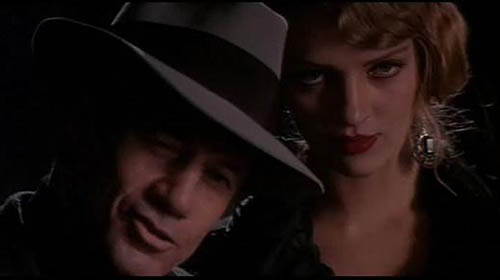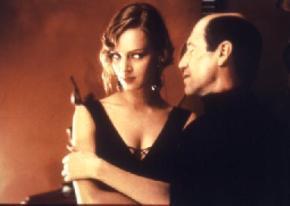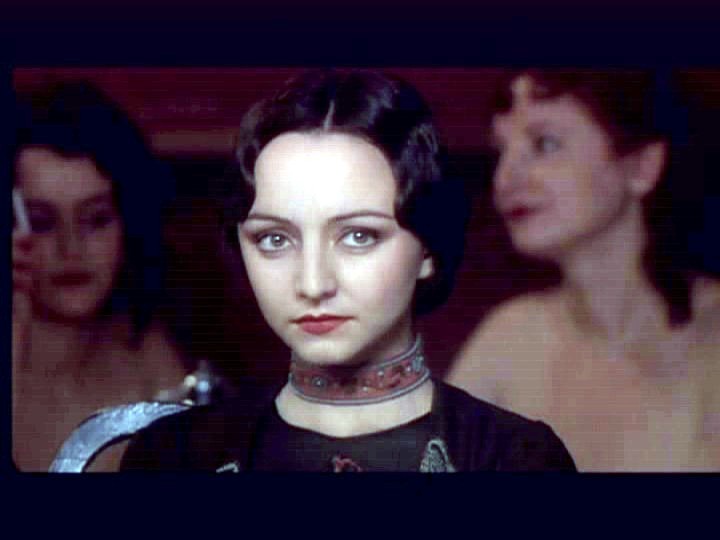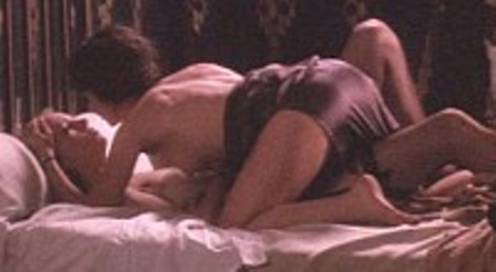From the Chicago Reader (October 26, 1990). — J.R.
HENRY & JUNE
** (Worth seeing)
Directed by Philip Kaufman
Written by Philip and Rose Kaufman
With Fred Ward, Uma Thurman, Maria de Medeiros, Richard E. Grant, Kevin Spacey, and Jean-Philippe Ecoffey.
“There are larval thoughts not yet divorced from their dream content, thoughts which seem to slowly crystallize before your eyes, always precise but never tangible, never once arrested so as to be grasped by the mind. It is the opium world of woman’s physiological being, sort of a show put on inside the genito-urinary tract. There is not an ounce of man-made culture in it; everything related to the head is cut off. Time passes, but it is not clock time; nor is it poetic time such as men create in their passion. It is more like that aeonic time required for the creation of gems and precious metals; an embowelled sidereal time in which the female knows that she is superior to the male and will eventually swallow him up again. The effect is that of starlight carried over into day-time.”
This elegant huffing and puffing belongs to Henry Miller, writing about the journals of Anais Nin in a 1939 essay called “Un Etre Etoilique” (A Starlike Being), collected in The Cosmological Eye. Whether or not one chooses to subscribe to its essentialist conceits about sexual difference, it helps to explain to what degree the sexual and literary relationship between Miller and Nin, which started and flourished in the 30s, was an attraction between opposites. (Miller’s joyously vulgar prose is devoted to bringing the sublime down to earth; Nin’s giddy and ethereal prose is devoted to elevating the commonplace.) It also helps to describe the sensual fantasia that Kaufman has tried and in some ways succeeded in weaving around Nin’s posthumous book Henry & June — an account of her passionate relationships with both Miller and his wife June in Paris in the early 30s, which is drawn from those same journals.
The story begins around the time that Nin (Maria de Madeiros) — married to a devoted and supportive banker named Hugo (Richard E. Grant), whom she lives with outside Paris — meets Miller (Fred Ward), who is sharing a tiny flat with their friend Osborn (Kevin Spacey) in Paris. It continues as she becomes infatuated with him and then with his enigmatic and emotionally scarred prostitute wife June (Uma Thurman) when she arrives from the states. After June returns to Brooklyn, Nin begins an affair with Miller, and both this affair and her infatuation with June are kept secret from Hugh, although he is aware of her fascination with both of them; she also has an intermittent affair with her cousin Eduardo (Jean-Philippe Ecoffey), who has long been smitten with her. Things reach a crisis after June returns from the states, and in the midst of making love with her — an incident which isn’t recorded in Nin’s book — Nin inadvertently reveals that she’s been sleeping with Miller, which leads June to walk out on both of them.
As a fanciful improvisation on the themes of Nin’s book, and one that depends to a great deal on atmosphere and a sense of the magical, Kaufman’s film has a certain amount going for it. For one thing, he has made a genuinely erotic film that doesn’t get its kicks from trashing women — an uncommon achievement these days, and one that harks back in some ways to Gustav Machaty’s Ecstasy (1933), a classic that Miller once eloquently championed himself, and which is quoted directly in the film. (It is the first of four films that the characters in Kaufman’s film are shown seeing; the others are Maedchen in Uniform, The Passion of Joan of Arc, and Un chien andalou.)

From his three leads, Kaufman has coaxed striking and suggestive performances that give the characters a fair amount of density, despite the fact that the two title characters are filtered through the highly subjective and partial point of view of Nin, which makes them register as fragmented and somewhat incomplete. Miller’s intellectual qualities are undoubtedly short-changed (by the Kaufmans, not Nin), but judging from a French TV documentary on Miller that I saw many years ago, Ward has caught his vocal and facial mannerisms — including such details as his grunts of contentment and his Brooklyn accent — with remarkable accuracy. I can’t vouch for any comparable accuracy where the two women are concerned, but Medeiros and Thurman are certainly vivid and powerful, both leaving impressions that linger.
But I have to admit to certain misgivings about some of the ways that Kaufman has gone about his adaptation. What mainly irritated me about his previous film, The Unbearable Lightness of Being, for all its own sensual virtues, was how dutifully he scaled down the dimensions and complexities of Milan Kundera’s novel to what his audience already thought it knew about Czechoslovakia, and eliminated just about everything else — especially what the novel had to say about kitsch and the U.S. — that interfered with that complacency. In less obvious ways, Henry & June can be accused of a related kind of pandering.
Whatever its value as a document, and despite the power of some of its writing, Nin’s Henry & June can’t be regarded as a literary masterpiece on the same level as Kundera’s novel. Furthermore, the fact that Kaufman has taken even greater liberties with his material in this case — adding many scenes (some of them, perhaps, derived from other sources, like Miller’s books) and eliminating major characters and other aspects of the real-life story — is perfectly understandable, given the task of adapting such unwieldy material into a film.
I only wish that in conjuring up his magic, Kaufman hadn’t depended so much on touristic notions about Paris and bohemian life that are already firmly entrenched in the popular imagination. The film intermittently and effectively creates a Paris of dark, dank, smoky, cramped yet cozy interiors — small flats and cafes, claustrophobic bars, restaurants, and movie auditoriums — that adds appreciably to the film’s sensuousness, and incidentally corresponds to my own memories of such places during the five years I lived in Paris in a much later era (1969-74). But whenever the characters step out of these interiors into the street, the setting becomes an ersatz tourist’s view of the city consisting of magicians, female contortionsts, Beaux Arts costumes, a comic in a gorilla suit, and an accordion player, all of whom seem to devote most of their waking lives to entertaining the other characters. Most of these, I should hasten to add, turn up in the interiors as well, mainly in bars and at parties, and I suppose one could justify this human décor as poetic “atmosphere,” and further rationalize it as another indication of just how enclosed and cut off from ordinary life this bohemian universe is supposed to be (a debatable point, incidentally, if one compares this vision to Miller’s own books). I should add, moreover, that many of the magic tricks are delightful and charming, both in themselves and in the ways that Kaufman integrates them in the mise en scène.
But conceptually speaking, these details grate because they match so precisely cliches about Parisian bohemia that already circulate elsewhere, and which seem designed more to flatter than to actually reduce the audience’s remoteness from such a milieu. They had the effect on me at times of making the movie into less of a privileged dream bubble, and more of a voyeuristic middle-class fantasy about the world of bohemian artists — a corny sop to squares that is very much in keeping with the movie’s worst gag, which involves Anais and Hugo’s horrified maid crossing herself after she finds Henry lying beside the two of them on their bed.
Similarly, when Nin is shown exploring Miller and Osborn’s apartment for the first time, unaware that anyone else is around, she accidentally stumbles into Osborn’s bedroom, where he’s lying in bed with no less than four naked, nubile women — a moment fully worthy of an Albert Zugsmith classic like The Beat Generation, and one that, like the smug gag with the maid, elicits all the expected titters from the audience. One extended sequence shows the characters with the famous French photographer Georges Brassai (Artus de Penguern), a friend of Miller’s, while he is photographing street life in various locations, and judging from what we see, a folksy accordion player performing evocative French ditties was as essential to Brassai’s artistic technique as his camera — the same jolly peasant turns up everywhere Brassai stations his equipment, apparently performing his cheerful services gratis.
The point isn’t that Paris doesn’t — or didn’t — have any vestiges of this kind of street life, but that Kaufman lays it on with a kind of sentimental excess that would be more appropriate to a 50s musical like An American in Paris or Funny Face. It doesn’t make room for the characteristic street performers I recall such as the Left Bank’s notorious Rat Man — a grungy clochard who made his living with a rubber rat attached to a string that he would fling at unsuspecting pedestrians, mainly female, for the amusement of nearby cafe patrons, before passing the hat for his performance. I’m not claiming that Kaufman’s under any obligation to be realistic, but I regret that his taste for fantasy keeps dipping into the common trough, and avoids poking around for fresher representations of this world.
I have related problems with Kaufman’s use of the opening strains of Stravinsky’s The Rite of Spring (1913), not only at the beginning of the film, but twice again soon afterwards. It’s a piece that I adore, but I’ve always felt that Pauline Kael’s famous allusion to it in her review of Last Tango in Paris, which essentially relates its power to an extremely vague compound of elements (sex and eroticism plus avant-garde art plus Paris), is an extremely reductive vulgarization of what Le sacre du printemps both is and does. Kaufman’s repeated use of it here seems like a telegraphed message to the audience that pushes this reduction even further, as if he were alluding to the Bertolucci film as well as the Stravinsky ballet. (The fact that Kael has been Kaufman’s biggest critical supporter may not be entirely irrelevant to this nod.) Even if the Stravinsky-Bertolucci-Kael connection was unintended, it still seems to me a rather hokey and misleading idea to connect Nin and Miller as avant-garde artists — either separately or collectively — with Stravinsky, because doing so flattens the meaning and significance of all three, implicitly turning them all into comic-book versions of themselves for the sake of middle-class consumption. (Those crazy, sex-mad, flamboyant artists.) Similarly, when the film later makes use of an Erik Satie piano piece, you can be sure that it’s the same Satie piano piece you’ve heard many times already, in numerous other films. Finally, when the film concludes with a rundown of what happened to all the major characters afterwards à la American Grafitti, one feels once again ejected out of the world intermittently created in this film and thrown into another world that is much more commonplace — not the “real” world, as was obviously intended, but the world of other movies that conclude with compulsive taglines about their characters. In sum, it’s as if Kaufman were trying to cushion everything that was most dangerous, exciting, and liberated about his leading characters with a collection of moldy golden oldies — venerable movie standbys — to keep them and their world cute, colorful, familiar, and time-tested.

Yet in striking contrast to all this background and supplementary material, Kaufman’s treatment of the major characters is for the most part respectfully detached and nonjudgemental. When he throws in yet another familiar trope — the idyllic bicycle ride through the countryside taken by Henry, Hugo, Anais, and June, which is clearly supposed to remind us of Jules and Jim (and not of the countless other movies with idyllic bicycle rides meant to remind us of Jules and Jim) — the reference boomerangs to some extent, because the freedom of the menage a trois in that film is largely predicated on their openness and lack of concealment, while the affairs here are principally founded on deceit and betrayal. (Significantly, the Kaufmans have cut back a bit on the full range of her love life during this period, which also included, among other escapades, a passionate involvement with a psychiatrist whom she, Eduardo, and Hugo were all seeing more or less concurrently.)
But the film’s refusal to pass judgment on this deceit and to allow the characters to speak for themselves — allowing June, for instance, to speak of betrayal without either endorsing or undercutting her remarks — is exemplary, and the film is similarly open-minded in its general depiction of Nin’s odyssey of sexual self-discovery. It is surely the film’s nonjudgmental treatment of lesbianism — and not its treatment of lesbian lovemaking per se — that earned this film the new NC-17 rating. Arguably, if this depiction had been scaled more to the puritanical and misogynist conventions of standard male titillation, and had included the standard divine retribution for lesbian desire — like, say, Dennis Hopper’s The Hot Spot — it would have initially been granted an R like the Hopper film rather than an X.
Perhaps if Kaufman were more graceful as a film stylist, and less of a literary director — if, for instance, he didn’t have to rely so much on closeups to create the film’s closeted, stifling hothouse atmosphere — he might have assimilated some of his fanciful background details in a manner that made their stylistic and ideological sources less apparent. But the constant closeups, frequent slow fadeouts and fancy matching cuts, and periodic classical musical cues all make us too aware of the effort involved in putting this world together. It is only in snatches that the characters and settings are fully allowed to take over, without need of Pavlovian reference points — Stravinsky, Satie, gorilla suit, contortionists, scandalized maid, and accordion ditties — to make them viable.











